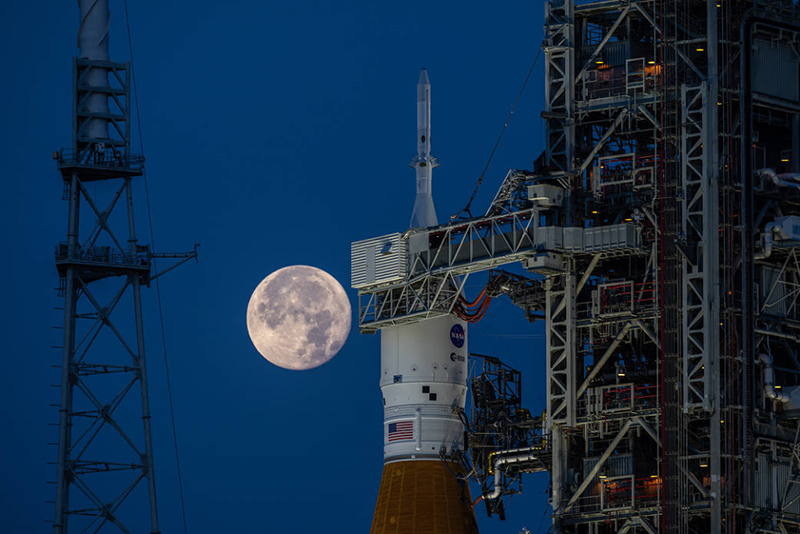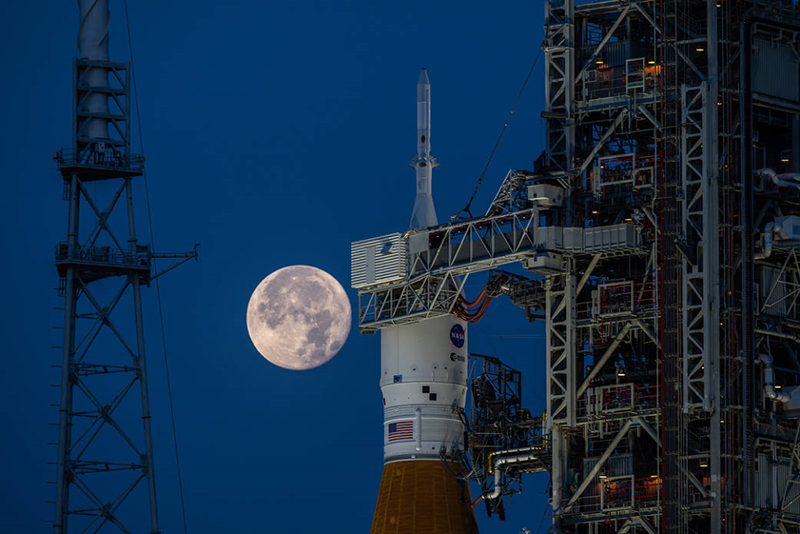A Time Standard for the Moon—Thanks to General Relativity
More than 50 years after their last visit, humans are preparing to go back to the Moon. As part of the Artemis program, NASA plans to land a pair of astronauts near the Lunar South Pole within the next few years, and other crewed missions are scheduled to be launched moonward in the coming decade. While this next generation of lunar explorers is getting ready, scientists on Earth are working out a new way to keep good time on the Moon [1, 2]. Using Einstein’s general relativity theory, these researchers have precisely calculated the expected differences between lunar and terrestrial clocks. The effort could help establish a time standard for the Moon, which would be instrumental in coordinating lunar exploration activities.
Technology has come a long way since the last Apollo mission in 1972. GPS navigation, for example, didn’t exist for the Apollo astronauts as they explored the Moon’s rocky expanses, but nowadays practically every phone is equipped with a GPS app to help us locate a restaurant or find the fastest route to home. GPS systems compute your location by measuring the time it takes a signal to travel between a GPS satellite and the receiver in your phone. But this computation only works by taking into account general relativity, which says that time ticks slower in stronger gravitational fields. If we take sea level as our reference point, then clocks at higher altitude—where gravity is weaker—will run faster. Clocks in satellites experience even less of Earth’s gravity, so they should run faster still (but the net rate will also depend on time-dilation effects coming from the satellite’s orbital motion). The typical GPS satellite runs about 38 µs faster per day compared to a sea-level clock at rest.
The Moon is even higher within Earth’s gravitational field, but it also has its own gravity. The rate at which a clock will run on the Moon is complicated to compute, as it will depend on the clock’s position and speed relative to Earth. “With the increasing number of lunar missions in the next decade, it will not be practical or feasible for each of those individual missions to obtain their respective times via a link with Earth,” says Javier Ventura-Traveset, Lunar Navigation and Science Manager at the European Space Agency.
This challenge prompted the White House to issue a memorandum in April of this year to establish a time standard for the Moon by the end of 2026. Among the specifications for this lunar time, it should be independent of terrestrial clocks, accurate enough for navigation and science, convertible to Earth’s time, and scalable to other environments, such as Mars.
To help lay a framework for establishing a time standard on the Moon, Neil Ashby and Bijunath Patla of the National Institute of Standards and Technology, Colorado, calculated the clock ticking rate on the Moon and proposed a method to sync clocks on Earth with those on the Moon [1]. “You have to have an estimate that accounts for the effects of relativity so that when a real clock is put on the Moon, we can compare its accuracy,” says Patla.
He and Ashby started by treating the Moon as a satellite without its own gravitational potential. The same treatment is used to calculate the relativistic offset for GPS satellites—the difference being that the distance from Earth is not 20,000 km (for the typical GPS satellite altitude) but rather 380,000 km (for the Earth–Moon separation). In this simplified picture, the Moon’s clock would tick about 58 µs faster per day than on Earth.
But, unlike a GPS satellite, the Moon has significant gravity. To model this, the researchers used generalized Fermi frames, a coordinate system that allowed them to treat Earth and the Moon together in a free-falling inertial frame around the Sun. By doing this, they determined that time on the Moon runs 56 µs faster per day.
Similar calculations were performed by Sergi Kopeikin from the University of Missouri and George Kaplan from the US Naval Observatory, Washington, DC [2]. Like Ashby and Patla, these researchers found that time on the Moon runs on average 56 µs faster per day than on Earth. But Kopeikin and Kaplan use a formalism that includes higher order relativistic terms. “These additional terms, although periodic, have a significant amplitude that affects lunar navigation,” Kopeikin says. He explains that accounting for these periodic terms could offer nanosecond-level accuracy to Earth-to-Moon time conversion.
But knowing this conversion doesn’t solve all the issues of lunar timekeeping. “As the number of assets on the Moon increases over time and more robotic missions are planned, it is desirable that the rovers communicate and navigate on the lunar surface autonomously and be less reliant on Earth-based command and control centers,” Ashby says.
To implement an Earth-independent lunar time, Ashby and Patla suggest a network of clocks, both on the lunar surface and in orbit. This strategy would be similar to how a universal time is calculated on Earth. Across Earth’s surface, there is a network of hundreds of atomic clocks. Each of these clocks ticks at a slightly different rate, given its elevation. By correcting for the speed of these ticking clocks from general relativity, researchers have established a global reference called International Atomic Time (TAI). TAI is currently ahead of the Coordinated Universal Time (UTC) by 37 s, because UTC is adjusted with leap seconds to keep in sync with Earth’s rotation.
A network of clocks on the surface of the Moon would offer a Coordinated Lunar Time (LTC) that all space-faring nations could use. “An agreed-upon common lunar time reference will be essential to ensure the technical synchronization of lunar-based interoperable infrastructures, the economic development of the Moon, and the proper execution of scientific activities on the lunar surface,” Ventura-Traveset says.
A lunar time standard would have other benefits with regards to astronaut health, says Ethan Waisberg of the University of Cambridge, who studies space-related medical conditions. Establishing an LTC “would ensure consistency in experimental data logging by providing a standardized lunar time zone, making it easier to compare data across various groups,” he says. Such comparisons are critical, he says, in understanding time-dependent conditions that affect astronauts, such as an eye-swelling effect called spaceflight-associated neuro-ocular syndrome.
To distribute time signals across the lunar surface, clocks could be flown in satellites around the Moon. Ashby and Patla also suggest placing satellites at Lagrange points—stable points in the gravitational potential of Earth and the Moon. “A Lagrange point has the property that an object placed there will remain there, so it doesn’t take much fuel for station keeping,” Patla says. These satellites could also serve as time-transfer links between clocks on Earth and those on the Moon.
Looking further ahead, establishing a lunar time system could provide a better understanding of how relativity affects the speed of time on various celestial bodies, which might help us adapt our clocks for future destinations, such as Mars.
–Elizabeth Fernandez
Elizabeth Fernandez is a freelance science writer based in Raleigh, North Carolina.
References
- N. Ashby and B. R. Patla, “A relativistic framework to estimate clock rates on the Moon,” Astron. J. 168, 112 (2024).
- S. M. Kopeikin and G. H. Kaplan, “Lunar time in general relativity.,” arXiv:2407.04862.





